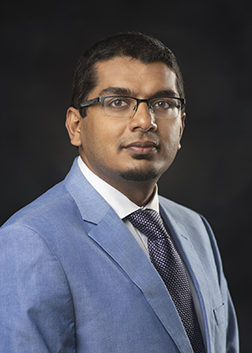DoD grant positioning MSU as leader in tilt-wing aircraft research

Shreyas Narsipur
A Mississippi State engineering study could shape the future of tilt-wing plane design thanks to a $600,000 U.S. Department of Defense grant and a one-of-a-kind wind tunnel.
The grant, from the defense department’s Established Program to Stimulate Competitive Research, is funding research to better understand the challenges of transitioning propeller-based aircraft from vertical to horizontal flight. The three-year project will leverage MSU’s strengths in experimental, computational and flight research to establish the university as a leader in multidisciplinary aeronautical engineering, and the grant will allow researchers to systematically build up testing capabilities, including the development of a unique reverse wind tunnel system.
“Tilt-wing aircraft must transition efficiently from vertical hover to horizontal cruise flight for optimal performance, flight duration and safety. Understanding this transition is important for establishing the design challenges for the next-generation tilt-wing aircraft being developed for military and urban operations,” said Shreyas Narsipur, the MSU Department of Aerospace Engineering assistant professor leading the project. “Winning this award is very validating. This research idea and setup is a bit risky, and it’s encouraging to know that the Department of Defense sees value in it.”
Use of propeller-based aircraft in both military and civilian applications has risen due to requiring aircrafts—largely unmanned aerial systems—to fly at lower altitudes and speeds, Narsipur said. This, in addition to the push for emission-free aviation using batteries, has led to the exploration of using electric hybrid/tilt-wing aircraft which offer vertical/short takeoff and landing capabilities. Currently, Narsipur said, electrical V/STOL is not very efficient for an aircraft as it eats into a large portion of the available power, leading to lower aircraft range and endurance. Practical implementation of propeller-based tilt-wing aircraft technologies is mainly hampered by the lack of understanding of the aerodynamics in the transition corridor.
A key aspect of the project is further developing the novel reverse-flow wind tunnel established by Narsipur and his doctoral student, Matthew White. Unlike conventional wind tunnels that blow air over stationary models, this unique setup will move scaled-wing aircraft models through still air. This allows for a more realistic simulation of the rapid airflow and angle changes during the transition. Project collaborator Shanti Bhushan, an associate professor of mechanical engineering and associate director of MSU’s Center for Advanced Vehicular Systems, will use high-performance computing to validate computational fluid dynamics simulations against wind tunnel data and provide additional off-body flow visualization.
“This project has the potential to significantly advance our understanding of the complex flow mechanisms of propeller-wing systems in transition, enable a physics-based understanding of the aerodynamics and establish the design challenges for said systems, all of which are essential to the development of high performance and endurance V/STOL vehicles,” Narsipur said.
Rani Sullivan, MSU Department of Aerospace Engineering head, said she is proud of the DoD recognizing Narsipur’s work, which “has broad and high impact in the area of aerodynamics that directly impacts the emergent field of unmanned aerial systems and urban air mobility.”
MSU’s Department of Aerospace Engineering is online at www.ae.msstate.edu and can be found on Facebook at @msuaerospaceengineering. The Bagley College of Engineering is online at www.bagley.msstate.edu and available on Facebook, Twitter, Instagram and YouTube at @msuengineering.
Mississippi State University is taking care of what matters. Learn more at www.msstate.edu.
Camille Carskadon | Bagley College of Engineering



